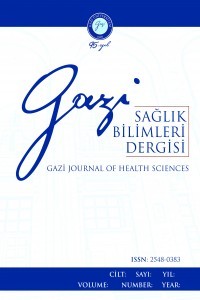ECZANELERDE AROMATERAPİ YAKLAŞIM VE UYGULAMALARI ÜZERİNE BİR ANKET
Aromaterapi, anket çalışması, eczane, uçucu yağlar, inhalasyon
A SURVEY ON AROMATHERAPY KNOWLEDGE AND PRACTICES IN PHARMACIES
Aromatherapy, questionnaire study, pharmacy, essential oils, inhalation,
___
- 1. Robins JLW. The science and art of aromatherapy. Journal of Holistic Nursing. 1999: 5-17.
- 2. Stevesen CJ. Aromatherapy in dermatology. clinics in dermatology. 1998; 16:689-694.
- 3. Dunning T. Aromatherapy: overview, safety and quality issues. OA Alternative Medicine. 2013;1(1):6
- 4. Dunning T. Applying a qualityuse of medicines frame work to using essential oils in nursing practice. ComplementaryTherClinPract. 2005;11(3):172–181.
- 5. Solorzano-Santos F, Miranda-Novales M. Essential oils from aromatic herbs as antimicrobial agents. CurrentOpinionBiotechnol. 2012;23(2):136–141.
- 6. Guba R. The modern alchemy of carbondioxide extraction. Int J Aromather. 2002;12(3):120–126.
- 7. Isman MB, Wilson JA, Bradbury R. Insecticidal activities of commercial rosemary oils (Rosmarinus officinalis) against larvae of Pseudaletia unipuncta and Trichoplusia ni in relation to their chemical compositions.Pharmaceutical Biology. 2008;46(1–2):82–87.
- 8. Sadlon A, Lamson D. Immune modifying and antimicrobial effects of eucalyptus oil and simple inhalation devices. AlternativeMedRev. 2010;15(1):33–47.
- 9. Bakkali F, Averbeck S, Averbeck D, IdaomarM. Biologicaleffects of essentialoils – A review. FoodandChemicalToxicology. 2008;46:446-475.
- 10. Buckle J. Use of aromatherapy as a complementary treatment for chronic pain. Alternative therapies in health and medicine. 1999;5(5):42-51.
- 11. Tiran D, Price S. Pregnancy and childbirth.In: Price S, Price L edıtor. Aromatherapy for health professionals. PublishedbyEdinburgh: Churchill Livingstone 2007p.269-283.
- 12. Buckle J. Essential Oil Toxicity and Contraindications. İn:Buckle J. Clinical Aromatherapy Essential Oils in Healthcare.published by Edinburgh: Churchill Livingstone; 2015p:73–94.
- 13. Buckle J. The Evolution of Aromatherapy. In: Buckle J. Clinical Aromatherapy Essential Oils in Healthcare. Published by Edinburgh:Churchill Livingstone; 2015 p:2–14.
- 14. İnfantil kolik tedavisinde kullanılan doğal kaynaklı ürünler. Academia 2015. Available at: https://www.academia.edu/13488806/%C4%B0NFANT%C4%B0L_KOL%C4%B0K_TEDA V%C4%B0S%C4%B0NDE_KULLANILAN_DO%C4%9EAL_KAYNAKLI_%C3%9CR% C3%9CNLER Accessed on September 14, 2021
- 15. Buckle S. Aromatherapy and Massage. Pediatric Nursing. 15(6), 24-27 (2003).
- 16. Bleasel N, Tate B, Rademaker M. Allergic contact dermatitis following exposure to essential oils. Australasian Journal of Dermatology. 2002;43:211–213.
- 17. Hajimonfarednejad M, Ostovar M, Raee MJ, Hashempur MH, Mayer JG, HeydariM.Cinnamon: A systematic review of adverse events. Clinical nutrition. 2019;38:594- 602.
- 18. Emery DP, Corban JG. Camphortoxicity. JPaediatr Child Health. 1999;35:105-6.
- 19. Radulovic NS, Gencic MS, Stojanovic NM, Randjelovic PJ, Stojanovic-Radic ZZ, Stojiljkovic NI. (Toxic essential oils. Part V: Behaviour modulating and toxic properties of thujones and thujone-containing essential oils of Salvia officinalis L., Artemisia absinthium L., Thuja occidentalis L. And Tanacetum vulgare L.) Food and Chemical Toxicology. 2017;105:355-69.
- ISSN: 2548-0383
- Yayın Aralığı: Yılda 3 Sayı
- Başlangıç: 2015
- Yayıncı: Gazi Üniversitesi
COVID-19 SALGININDA DİYABET YÖNETİMİ VE HEMŞİRENİN ROLÜ
Dilek BÜYÜKKAYA BESEN, Merve DERVİŞOĞLU
GEBELİĞİN KADIN CİNSEL FONKSİYONU ÜZERİNE ETKİLERİ
Ayten ŞENTÜRK ERENEL, Sıdıka PELİT AKSU, Gülten KOÇ
Ebrunur YILMAZ, Özlem VAROL AVCILAR, Fatma Bengü KUYULU BOZDOĞAN, Aybala TAZEOĞLU, Fatmanur GÖFER, Ayşegül BİLGİÇ
DİABETES MELLİTUSLU KADINLARDA CİNSEL FONKSİYONLARIN BELİRLENMESİ
Mehtap AKSOY, Ayten ŞENTÜRK ERENEL
ÜNIVERSİTE ÖĞRENCİLERİNİN MAHREMİYET BİLİNCİ
Deniz OZTURK, Gulcan EYUBOGLU, Zehra GÖÇMEN BAYKARA
YAĞ ASİTLERİNİN TİP 2 DİYABET GELİŞİMİ ÜZERİNE ETKİLERİ
ECZANELERDE AROMATERAPİ YAKLAŞIM VE UYGULAMALARI ÜZERİNE BİR ANKET
Eda GEDİK, Elif ÖZBİR ELEVLİ, Emine AKALIN
Elif SAKIZLI ERDAL, Abdullah OZER, Emetullah CİNDİL, İlke KESER
